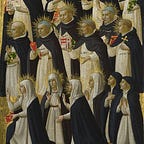St Catherine of Siena (part 2)
Finally, after an unintentional hiatus, I return to Catherine of Siena. I have already written about the mystical parts of Catherine’s life so this post will focus on her public life, her politics and her role as a preacher. Despite becoming hugely famous in her own time, Catherine’s public life was subsequently suppressed; her biographer, Raymond of Capua, skipped over these aspects of her life due to the controversy of Catherine’s position as an uneducated woman taking on such prominent public roles.
Catherine lived at what was a tumultuous time for Italy and for the papacy; Florence was effectively excommunicated by the Pope for rebellion and at this time there were two Popes, one in Rome, the other set up as a rival in Avignon. Catherine acted as an unofficial mediator between Florentine officials and the Pope during their dispute, travelling all the way to Avignon and promoting calls for a new crusade to the Holy Land while she was there. Although her mission failed to reconcile the Pope and Florence, this task established Catherine as an important figure in Italian religious politics. She remained an ardent supporter of Pope Gregory XI and his successor at Avignon, Urban VI. She realised Gregory’s return to Rome would be the best hope of bringing peace to Italy and worked for the rest of her life to achieve this.
She moved to Rome at the request of Urban and from there worked to secure greater support, writing letters to important people including Queen Giovanna of Naples. Her letter to Giovanna is, I think, particularly telling of Catherine’s character as although she greets Giovanna with the traditional reverence, the tone of the letter is extremely harsh, threatening both Giovanna’s life and her immortal soul. This would be impressive under any circumstances but is even more so when you remember that Catherine was still illiterate and the daughter of a dyer. She was utterly unfazed by any authority.
Catherine, despite her illiteracy, had a huge amount of literary output, of which 380 letters, 26 prayers and four treaties survive. All were dictated and narrate various aspects of her life and beliefs. The four treaties make up the Il libro della divina dottrina, better know as The Dialogue. They narrate in vivid and emotional language her mystical experiences through a conversation between her soul and God and were said to be dictated while Catherine was in ecstasy. They explore Catherine’s complex theological beliefs in great detail and are an important tract to the Catholic Church to this day. Especially interesting is how her understanding of gender filters through the work; she describes her soul as androgynous while using a mixture of pronouns. The conception of gender within the medieval church is a hugely interesting and complex topic that I hope to cover in a succinct way soon.
Catherine’s letters demonstrate that this public side of her life was as important to her as her mysticism, but it caused controversy, mainly down to the misogyny of the Middle Ages. Women were prevented from preaching, and not only did Catherine preach but she was a figure of influence for the papacy. Raymond deliberately suppresses these elements of her life in his biography and only provide the smallest hints of why. His description of the criticisms of Catherine, the main one of which was that “She is a woman! If she wants to serve God, why doesn’t she stay at home?”. Raymond says Catherine only pursued a public life because Christ told her to do, however it doesn’t take much reading between the lines to see Raymond frantically trying to justify this less saintly (to the male mind) part of Catherine’s life. It is such a blessing that her letters survive to counteract this image.
Catherine died in Rome while working for Urban. She was only thirty-three years old and presumably weakened by her repeated fasting and aesthetic lifestyle. Her impact on Italy during her lifetime has been vastly overrated, however now the record is beginning to be set straight and she is remembered as much more than simply a mystic.
There are huge amounts of literature on Catherine of Siena but the below suggestions are great places to start. The first three are translations of Raymond’s biography and Catherine’s works. They are not the easiest reads but they are the best way to understand her.
Raymond of Capua, Life of Catherine of Siena, trans. G. Lamb (Charlotte, NC: Tan Books, 2003)
Saint Catherine of Siena as seen in her letters, trans. V. Scudder (London: J. M. Dent & Sons, 1927)
The Dialogue of the Seraphic Virgin Catherine of Siena, trans. A. Thorold (London: Kegan Paul, 1907)
Luongo, F. T., The Saintly Politics of Catherine of Siena (Ithaca NY: Cornell University Press, 2006)
Scott, K., ‘St Catherine of Siena, Apostola’ Church History, 61 (1992) 34–46
Companion to Catherine of Siena ed. C. Muessig, G. Ferzoco, B. M. Kienzle (Leiden: Brill, 2012)
